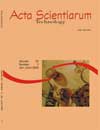Integration of the laser scanner with image panchromatic of QuickBird II in identification of building using neural network and region orientation
DOI:
https://doi.org/10.4025/actascitechnol.v27i2.1489Keywords:
sensoriamento remoto, redes neurais artificiais, laser scannerAbstract
The images produced by QuickBird II sensor and laser scanner data are expensive products to commercialize. Therefore, it has shown its value in the processing of digital images. The goal of this work is to show a viable option for building identification through high resolution image classification using laser scanner system data and images of QuickBird II. For doing so, it used intensity and altimetry laser data integrated with the panchromatic band of the QuickBird II sensor; by means of neural network algorithms and a region oriented approach. The work is justified because it uses recent technologies (laser scanner and QuickBird II images), and it can reduce the production costs of a thematic map. The method showed viable the elaboration of a thematic mapDownloads
Download data is not yet available.
Downloads
Published
2008-03-27
How to Cite
Botelho, M. F., & Centeno, J. A. S. (2008). Integration of the laser scanner with image panchromatic of QuickBird II in identification of building using neural network and region orientation. Acta Scientiarum. Technology, 27(2), 207–213. https://doi.org/10.4025/actascitechnol.v27i2.1489
Issue
Section
Photogrammetry/Remote Sensory
License
DECLARATION OF ORIGINALITY AND COPYRIGHTS
I Declare that current article is original and has not been submitted for publication, in part or in whole, to any other national or international journal.
The copyrights belong exclusively to the authors. Published content is licensed under Creative Commons Attribution 4.0 (CC BY 4.0) guidelines, which allows sharing (copy and distribution of the material in any medium or format) and adaptation (remix, transform, and build upon the material) for any purpose, even commercially, under the terms of attribution.
Read this link for further information on how to use CC BY 4.0 properly.
0.8
2019CiteScore
36th percentile
Powered by 



0.8
2019CiteScore
36th percentile
Powered by 

















8.png)




